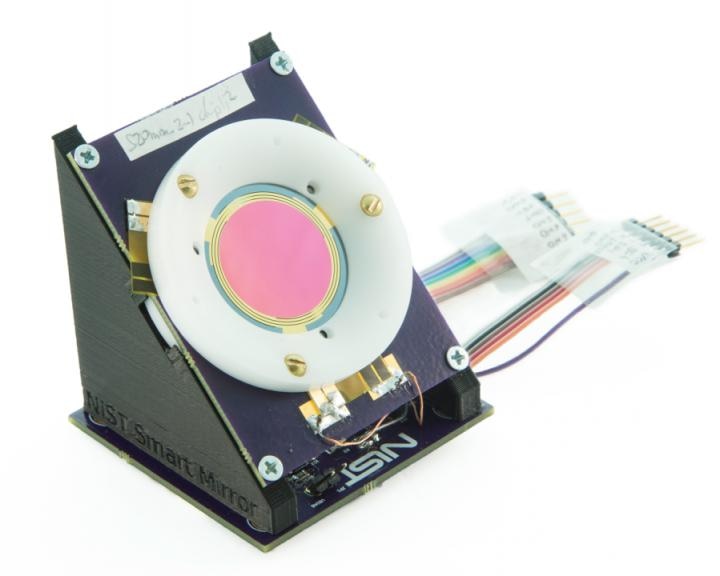May 30 2018
At present, high-power lasers are broadly applied in laser welding and additive manufacturing systems for precision welding and cutting of metal, producing all types of metal parts for automotive industries, aerospace applications, medical devices, and others.
 (Credit: A. Artusio-Glimpse/NIST)
(Credit: A. Artusio-Glimpse/NIST)
The increase in industrial application of high-power laser processing has resulted in manufacturers increasingly looking for point-of-use, high-accuracy laser power meters with the ability to rapidly report laser powers at any point in the manufacturing process. This aspect is crucial for controlling product quality. However, conventional laser power meters often have massive size and slow response time. Moreover, power measurements can be taken only separately, thereby hindering the manufacturing process.
At present, a research team from National Institute of Standards and Technology (NIST) in Boulder, Colorado, has designed a smaller, more rapid, and more sensitive laser power meter resembling a folding mirror, known as a “smart mirror.” The innovative design involves using a capacitor-based force transducer and merging optical elements — that is, a high reflectivity mirror — and sensing elements into a compact cube package.
It is possible to conveniently embed the four-centimeter-on-a-side cubes into laser-welding systems or laser optical systems for real-time, point-of-use laser power measurement and calibration. The innovation will be exhibited by the team at the OSA Imaging and Applied Optics Congress, to be held between June 25th and 28th in Orlando, Florida, United States.
Measuring laser power by measuring the pressure of a laser beam hitting a mirror is a very unique technique, [and] so far it is the only laser power measurement technique that is truly an in-situ process.
stated Alexandera B. Artusio-Glimpse, a scientist of NIST in Boulder, Colorado, and the primary author.
Artusio-Glimpse added, “Unlike any other optical power measurement techniques, our method allows us to continue using the laser for work while a measurement is being taken.”
Artusio-Glimpse elucidated that in conventional high-power meters, laser power is measured by the absorption of the entire energy of a laser beam as heat and by the measurement of the change in temperature. For the calorimetric measurement to be taken, the laser beam must be temporarily stopped from working for nearly tens of minutes.
“Using our ‘Smart Mirror’ laser power meter, that stop-measure-continue process is no longer needed. Manufacturers can measure the laser power continuously during every weld and monitor the laser calibration in real time, they would know right away whenever the laser has a problem and wouldn’t risk wasting metal parts with bad welds,” stated Artusio-Glimpse.
The Smart Mirror laser power meter is also called as a radiation pressure power meter (RPPM) because the operating principle of this meter is dependent on the measurement of the pressure of the laser, the radiation pressure. Although light has no mass, it has momentum and when an object (for example, a mirror) is struck by a laser beam, a tiny force called as the radiation pressure is exerted on the mirror, which is directly correlated to the laser power. For instance, 200 W of laser power exerts a force equivalent to 100 μg, which is approximately equal to the weight of a single eyelash of humans.
The most important part of the Smart Mirror design is a capacitor-based compact force transducer. It contains a spiral planar silicon spring that supports a circular plate, one side of which is equipped with a high reflectivity mirror and the other side with an electrode. An identical silicon spring including an electrode is located close to the first spring in a way that the two electrodes face one another, thereby forming a variable capacitor. A laser beam reflected off from the mirror on the first spring pushes the first spring to move toward the second and alter the capacitance between the two electrodes.
By performing comparisons with a fixed reference capacitor, the scientists can compute the laser power and radiation pressure. Once the laser beam is reflected off the mirror, it can be used directly for work, thereby enabling real-time monitoring of laser calibration or laser power.
Artusio-Glimpse stated that the group has been building the innovative radiation pressure power meter for many years and in an earlier version of RPPM, a commercially available scale with a mirrored surface was used as a force transducer. The size of the resultant system was close to that of a shoebox, with a measurement sensitivity of 50 μg and response time of 5 seconds.
In the latest version of the Smart Mirror, the measurement sensitivity was enhanced by 100 times and the response time was decreased by 50 times by the team. They also eliminated static sagging errors of the device arising due to gravity upon rotating the device.
This enables the sensor to be embedded at the end of a robotic arm or in additive manufacturing and laser welding systems in which the laser head moves and rotates — an important feature that was lacking in the previous version of bulk RPPM. It also satisfies the measurement requirements of various commercially important applications.
Preliminary tests revealed that the new meter is adequately sensitive to measure 100 W of laser power with an uncertainty of less than 1%, and with a response time rapid than any other absolute high-power laser meter. At present, the scientists are continuously validating these outcomes by conducting more tests. Artusio-Glimpse stated that the NIST researchers look forward to establishing a primary standard version of the Smart Mirror laser power meter in the near future.